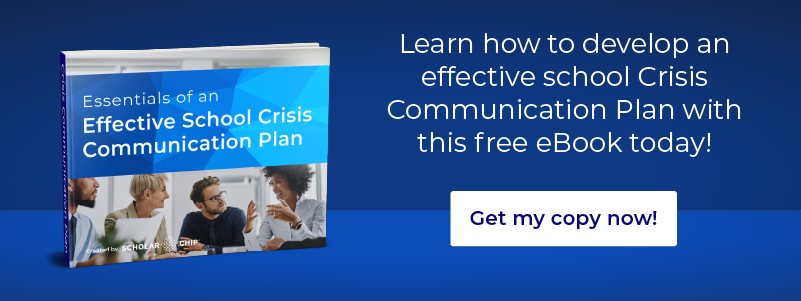Every school district requires an emergency or crisis plan. A crisis communication plan isn’t required as often but is just as important. In the event of an emergency, a communication plan ensures that information can get out to families and the public and keeps the message clear and consistent without adding unnecessary stress to your staff.
An emergency can be chaotic. However, the calmer that your staff can be in the face of a crisis, the greater confidence that the school community will have in your ability to deal with the crisis. Developing a crisis communication plan sets your school up to provide relevant information if the need should arise.
Create a Response Team
The first thing to do when developing a crisis communication plan is to designate a response team. This team is a powerful tool during an emergency and with a solid plan in hand, can extend your ability to keep the school community and public informed with a clear and consistent message.
Once the team members have been assigned roles, the next step is to get everyone up to speed on what the expectations are for their roles and how each of them will participate in the communication process during an active crisis. Sharing these expectations will translate into staff taking the right actions at the right time and knowing when and how to step in where needed.
For instance, it’s unrealistic to expect that the principal will be available to talk to the media or send out messages throughout a crisis. More than likely, they will be dealing with managing the emergency itself and making decisions. When the response team knows their roles and what to do, the next member of the team can step in at any time to share information just as the principal would. This keeps information flowing to parents and the community while guaranteeing that the message is consistent.
Determine Where and How You’ll Communicate
As you begin forming a crisis communication plan, you’ll quickly realize that there are almost as many channels of communication for you to use as students in your school. Physical letters and notes, email, social media, websites, radio and other media, phone and text messages, etc. must be considered. There is no need to use all of them. Instead, choose the ones that will reach the largest percentage of your school community and are easily accessible by everyone.
You’ll have a greater ability to steer the conversation within your own communication outlets, such as releases, emails, and alerts. The same cannot be said of communication with the media.
Because of this, consider how you’ll communicate with media outlets during a crisis. Each type of emergency may have a different media communication protocol.
The most effective strategy is to assign each response team member to various channels to prevent burnout or overwhelm. For media outlets, you should tap a hierarchy of response team members who can provide news teams information for when you’re unavailable. Include in your plan touchpoints to meet as a group to keep the message and updates on point.
Your plan should use communication timelines that align with your crisis response plan. Doing so will get the most recent and relevant information out at critical points during an emergency. Similarly, your crisis communication plan should be incorporated back into your emergency plan.
Define Information and Communication Templates
Communication plans should be created with an eye on keeping families and the community informed. However, they should be tooled to protect student and family privacy as well.
Part of your plan should be dedicated to defining and recording policies and procedures around what information can be shared and what data should be protected. Your response team should be able to point back to school policies on releasing personal information when asked for it by concerned parents and media outlets.
Communication templates can help your team adhere to those policies and provide a framework to kick-start communication. Information and situations may be fluid during a crisis, but templates can still be created to focus the response team’s efforts in the midst of the potential chaos.
Understand the Tools You’ll Need
WIth your channels, templates, and policies in place, you can now turn to the tools that you’ll need to effectively communicate. Technology can help here and provide both the means of sharing information and gathering it.
Outbound communication will likely involve supplying your team with the right tools, like laptops, computers, or mobile devices, as well as access or logins to the accounts that they will use for sending out or posting information.
Other technology tools can facilitate reaching the right people and having accurate information to share. For instance, automated attendance systems can speed up a school’s ability to reach the appropriate families impacted by an event, should the need arise. These systems can also give accurate data on the number of students in a given classroom or the school as a whole or help identify students who might be absent or missing.
Centralizing student data and school information in an administrative portal streamlines communication and ensures that accurate information is shared. An admin portal gives response teams a single source of information to use, which contributes to clarity. Additionally, some electronic communication can be automated from a central admin portal, letting the response team concentrate on other tasks.
Crisis communication plans are as important in managing an incident as an emergency plan. Clear communication during a crisis will keep the community confident in your ability to handle the situation. Having a plan will also let you define the information that you’re willing and able to share with the media and on the internet while protecting families and students. To achieve this, though, you need to invest the time in developing a crisis communication plan well ahead of the need and align it with your emergency plans.
Here at ScholarChip, we’re dedicated to helping school leaders maximize the safety and well-being of students and the entire school community.
Want to develop an effective school crisis communication plan but not sure where to start? Feel free to chat with one of our school crisis communication specialists today!


